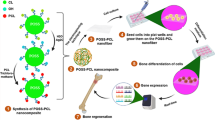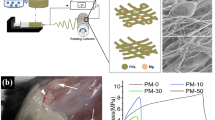Abstract
Electrospun nanofibers mimicking the extracellular microenvironment have tremendous potential for tissue regeneration applications. However, a lack of bioactive functionalities limits the effective utilization of nanofibers fabricated from synthetic biodegradable polymers. The objective of this study was to conjugate mesenchymal stem cell affinity peptide (EPLQLKM, E7) with star-shaped poly(L-lactide-co-ε-caprolactone) (PLCL) copolymer and to evaluate the potential of this modified polymer to enhance stem cell adhesion and proliferation in vitro. MSCadhesive peptide was covalently conjugated with the hydroxyl functionalities of the star-shaped PLCL copolymer and nanofibers were prepared by mixing appropriate proportions of linear PLCL and E7-conjugated star-shaped PLCL copolymers using electrospinning. Nuclear magnetic resonance and amino acid composition analysis revealed that E7 was successfully conjugated to PLCL copolymers. Nanofibers were smooth and homogenous as examined using scanning electron micrography. Nanofibrous meshes containing PLCL-E7 showed significantly higher cell viability and proliferation compared with the control group. In addition, cells spread well on meshes containing PLCL-E7 compared with the control group. The strategy adopted here may be very useful for designing stem cell adhesive polymeric biomaterials to enhance stem cell-based tissue repair. In addition, E7-immobilized PLCL copolymers can be fabricated into different shapes and structures as needed for various tissue engineering applications.

Similar content being viewed by others
References
M. Gnecchi, Z. Zhang, A. Ni, and V. J. Dzau, Circ. Res., 103, 1204 (2008).
C. K. Hashi, Y. Zhu, G-Y. Yang, W. L. Young, B. S. Hsiao, K. Wang, B. Chu, and S. Li, PNAS, 104, 11915 (2007).
M. Shafiq, Y. Jung, and S. H. Kim, Biomaterials, 90, 85 (2016).
D. E. Discher, D. J. Mooney, and P. W. Zandstra, Science, 324, 1673 (2009).
A. Leal-Egana, A. Diaz-Cuenca, and A. R. Boccaccini, Adv. Mater., 25, 4049 (2013).
W. Leong and D. A. Wang, Trends. Biotechnol, 33, 653 (2015).
U. Hersel, C. Dahman, and H. Kessler, Biomaterials, 24, 4385 (2003).
M. D. Pierschbacher and E. Ruoslahti. Proc. Natl. Acad. Sci. U.S.A., 81, 5985 (1984).
B. P. Gray and K. C. Brown. Chem. Rev., 114, 1020 (2014).
Q. Li, Z. Wang, S. Zhang, W. Zheng, Q. Zhao, J. Zhang, L. Wang, S. Wang, and D. Kong, Mater. Sci. Eng. C: Mater. Biol. Appl., 33, 1646 (2013).
F. Gelain, S. Panseri, S. Antonini, C. Cunha, M. Donega, J. Lowery, F. Taraballi, G. Cerri, M. Montagna, F. Baldissera, and A. Vescovi, ACS Nano, 5, 227 (2011).
Z. Shao, X. Zhang, Y. Pi, X. Wang, Z. Jia, J. Zhu, L. Dai, W. Chen, L. Yin, H. Chen, C. Zhou, and Y. Ao, Biomaterials, 33, 3375 (2012).
Q. Meng, Z. Man, L. Dai, H. Huang, X. Zhang, X. Hu, Z. Shao, J. Zhu, J. Zhang, X. Fu, X. Duan, and Y. Ao, Sci. Rep., 5, 17802 (2015).
H. Huang, X. Zhang, X. Hu, Z. Shao, J. Zhu, L. Dai, Z. Man, L. Yuan, H. Chen, C. Zhou, and Y. Ao, Biomaterials, 35, 9608 (2014).
M. Shafiq, Y. Jung, and S. H. Kim, J. Biomed. Mater. Res. A, 103, 2673 (2015).
M. Shafiq, Y. Jung, and S. H. Kim, Eur. Cell. Mater., 30, 282 (2015).
M. Shafiq, Y. Jung, and S. H. Kim, J. Biomed. Mater. Res., 104A, 1352 (2016).
Y. M. Shin, Y. B. Lee, S. J. Kim, J. K. Kang, J-C. Park, W. Jang, and H. Shin, Biomacromolecules, 13, 2020 (2012).
Y. M. Shin, H. Shin, and Y. M. Lim, Macromol. Res., 18, 472 (2010).
D. A. Barrera, E. Zyistra, P. T. Lansbury, and R. Langer, J. Am. Chem. Soc., 115, 11010 (1993).
D. Grafahrend, K. H. Heffels, M. V. Beer, P. Gasteier, M. Möller, G. Boehm, P. D. Dalton, and J. Groll, Nat. Mater., 10, 67 (2011).
D. E. Muylaert, G. C. van Almen, H. Talacua, J. O. Fledderus, J. Kluin, S. I. Hendrikse, J. L. van Dongen, E. Sijbesma, A. W. Bosman, T. Mes, S. H. Thakkar, A. I. Smits, C. V. Bouten, P. Y. Dankers, and M. C. Verhaar, Biomaterials, 76, 187 (2016).
W. Kuhlman, I. Taniguchi, L. G. Griffith, and A. M. Mayes, Biomacromolecule, 8, 3206 (2007).
P. P. Kuhl and L. G. Griffith-Cima, Nat. Med., 2, 1022 (1996).
C. J. Chun, H. J. Lim, K.-Y. Hong, K.-H. Park, and S. C. Song, Biomaterials, 30, 6295 (2009).
A. Phadke, Y. Hwang, S. H. Kim, S. H. Kim, T. Yamaguchi, and K. Masuda, Eur. Cell. Mater., 25, 114 (2013).
Z. Man, L. Yin, Z. Shao a, X. Zhang, X. Hu, J. Zhu, L. Dai, H. Huang, L. Yuan, C. Zhou, H. Chen, and Y. Ao, Biomaterials, 35, 5250 (2014).
J. Fernández, A. Etxeberria, and J. R. Sarasua, J. Mech. Behav. Biomed. Mater., 9, 100 (2012).
M. A. Dobrovolkaia and S. E. Mcneil, Nat. Nanotechnol., 2, 469 (2007).
T. I. Croll, A. J. O’Connor, G. W. Stevens, and J. J. Cooper-White, Biomacromolecules, 5, 463 (2004).
K. Cai, K. Yao, Y. Cui, Z. Yang, X. Li, H. Xie, T. Qing, and L. Gao, Biomaterials, 23, 1603 (2002).
J. Yang, J. Bei, and S. Wang, Biomaterials, 23, 2607 (2002).
P. K. Chu, Y. J. Chen, L. P. Wang, and N. Huang, Mater. Sci. Eng., R: Rep., R36, 143 (2002).
U. Hersel, C. Dahmen, and H. Kessler, Biomaterials, 24, 4385 (2003).
C. H. Park, Y. J. Hong, and K. Park, Macromol. Res., 18, 526 (2010).
W. S. Choi, J. W. Bae, Y. K. Joung, K. D. Park, M. H. Lee, J.-C. Park, and I. K. Kwon, Macromol. Res., 17, 458 (2009).
Author information
Authors and Affiliations
Corresponding author
Rights and permissions
About this article
Cite this article
Shafiq, M., Kim, S.H. Covalent immobilization of MSC-affinity peptide on poly(L-lactide-co-ε-caprolactone) copolymer to enhance stem cell adhesion and retention for tissue engineering applications. Macromol. Res. 24, 986–994 (2016). https://doi.org/10.1007/s13233-016-4138-x
Received:
Revised:
Accepted:
Published:
Issue Date:
DOI: https://doi.org/10.1007/s13233-016-4138-x




